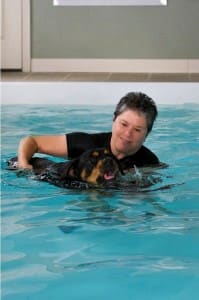Rocky’s Viewpoint

Did you know that hydrotherapy, or water exercise was first used with horses and racing greyhounds? These animals were constantly exposed to the jarring effects of gravity and hard surfaces, putting extra stress on their bones and joints often causing injury. Because of its effectiveness, hydrotherapy in a warm water pool (with a temperature between 88 and 92 degrees) has become popular in most dog and cat rehabilitation centers.
Swimming as an exercise eliminates the trauma experienced through walking or running on hard surfaces. Water provides res
Swimming is an excellent way to condition any dog especially those dogs that are recovering from surgery or injury, and those that are arthritic, geriatric or obese. The exercise stimulates the cardiovascular and lymphatic systems, strengthens muscles, increases flexibility and range of motion and allows painful joints to move comfortably. Dogs with arthritis, hip or elbow dysplasia, joint pain, cruciate ligament ruptures and bone fractures have made significant improvements thanks to water exercise. Dogs with neurological damage from spinal injuries or stroke have also shown marked improvements. Soft tissue injuries have been shown to respond well, but it can’t be rushed. And, an overweight dog who may be out of shape can trim down and increase his endurance and overall physical condition.
Guided swims are especially important for dogs to receive the optimum benefit from their swim sessions. A dog that dislikes or fears water can be encouraged to tolerate and benefit from the experience through the guidance, care and patience of the therapist. When there’s a sense of safety and calm in the water, the dog’s anxiety is naturally decreased.
There have been no clinical trials to show the effectiveness of hydrotherapy, only subjective observations from veterinarians, rehabilitation practitioners, dog trainers, owners and other pet professionals. All agree physical problems improve with swim therapy. Older dogs are more active and agile and have greater energy and coordination, arthritic dogs become more active, those with hip or elbow dysplasia have an easier time walking and climbing stairs, and dogs that compete in sports win or achieve their personal best.
If your dog is suffering from any of the conditions mentioned here, help your dog have a better quality of life by giving swim therapy a try. We know it works, and you will too!